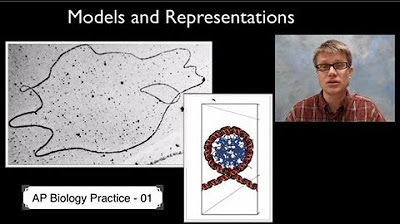2.5 Membrane Permeability - AP Biology
Summary
TLDRIn this AP Biology lesson, Mr. Poser delves into the concept of membrane permeability, a vital aspect of cell structure and function. He explains how the phospholipid bilayer's amphipathic nature—featuring hydrophilic heads and hydrophobic tails—gives the plasma membrane its selective permeability. While small nonpolar molecules can diffuse freely, larger polar molecules require assistance from transport proteins. The teacher also clarifies the difference between cell walls, composed of cellulose and providing structural support in plant cells, and cell membranes. The lesson highlights the importance of membrane proteins in facilitating the transport of essential molecules like glucose and sodium.
Takeaways
- 🧬 The plasma membrane is crucial for maintaining a cell's internal environment by selectively allowing substances to pass through.
- 🔬 The cell membrane's structure, being a fluid mosaic, primarily composed of phospholipid bilayers, plays a key role in its function.
- 💧 Phospholipids are amphipathic molecules with a polar phosphate head and nonpolar fatty acid tails, which arrange to face water-loving and water-repelling sides outward and inward, respectively.
- 🚫 The cell membrane is selectively permeable, meaning it allows certain substances to pass through more easily than others based on its structure.
- ✅ Small nonpolar molecules like gases (CO2, O2) can diffuse freely across the membrane due to their compatibility with the hydrophobic interior.
- ❌ Large polar molecules and charged molecules cannot easily pass through the membrane's hydrophobic core and require transport proteins.
- 🛠️ Transport proteins, such as channel and carrier proteins, facilitate the movement of larger or charged molecules across the membrane.
- 💧 Water, a polar molecule, can cross the membrane to some extent, but more efficiently through aquaporins, specialized channel proteins.
- 🌿 Plant cells have an additional protective layer, the cell wall, made of cellulose and other carbohydrates, providing structural support and a barrier for some substances.
- 🔎 It's important to distinguish between the cell wall and the cell membrane, as they serve different functions and are composed of different materials.
Q & A
What is the primary function of the plasma membrane?
-The plasma membrane separates the cell from its surroundings and allows cells to maintain a separate and stable internal environment.
What is the structure of the cell membrane described as?
-The structure of the cell membrane is described as a fluid mosaic, with the phospholipid bilayer making up most of it.
What is an amphipathic molecule and how does it relate to the cell membrane?
-An amphipathic molecule is one that has both polar and nonpolar regions. In the context of the cell membrane, the phospholipid, which is amphipathic, has a polar phosphate head and two nonpolar fatty acid tails.
How does the arrangement of the phospholipid bilayer contribute to the selective permeability of the membrane?
-The arrangement of the phospholipid bilayer, with the polar heads facing outward and the nonpolar tails facing inward, contributes to selective permeability by allowing small nonpolar molecules to pass through easily while hindering the passage of large polar molecules.
What is meant by the term 'selectively permeable' in relation to cell membranes?
-The term 'selectively permeable' means that the cell membrane allows some substances to pass through more easily than others, based on the structure of the membrane.
How do small nonpolar molecules like carbon dioxide and oxygen cross the plasma membrane?
-Small nonpolar molecules like carbon dioxide and oxygen can cross the plasma membrane by simple diffusion, moving from an area of high concentration to an area of low concentration.
What role do membrane proteins play in the transport of large polar molecules and charged molecules?
-Membrane proteins, such as channel and transport proteins, are essential for the transport of large polar molecules and charged molecules across the plasma membrane, as these types of molecules cannot pass through the hydrophobic fatty acid tails by themselves.
How does the cell membrane facilitate the passage of water molecules?
-Water molecules can pass through the plasma membrane in small amounts, but primarily they move through special channel proteins called aquaporins, which facilitate the passage of water from areas of high concentration to areas of low concentration.
What is the difference between a cell wall and a cell membrane?
-A cell wall, found in plant cells, is made of cellulose and provides structural support and a barrier for some substances. The cell membrane, on the other hand, is a selectively permeable barrier made mostly of phospholipids and is found in all cells, including plant cells.
Why are proteins an important component of the plasma membrane despite the membrane being mostly phospholipid bilayer?
-Proteins are an important component of the plasma membrane because they play a crucial role in the transport of essential molecules, such as glucose and sodium, which are necessary for cell function and cannot pass through the phospholipid bilayer by themselves.
Outlines

This section is available to paid users only. Please upgrade to access this part.
Upgrade NowMindmap

This section is available to paid users only. Please upgrade to access this part.
Upgrade NowKeywords

This section is available to paid users only. Please upgrade to access this part.
Upgrade NowHighlights

This section is available to paid users only. Please upgrade to access this part.
Upgrade NowTranscripts

This section is available to paid users only. Please upgrade to access this part.
Upgrade NowBrowse More Related Video

2.10/2.11 - Compartmentalization/Origins of Compartmentalization - AP Biology

2.6 Membrane Transport - AP Biology

AP Biology Practice 2 - Using Mathematics Appropriately

3.1/3.2 Enzyme Structure + Catalysis - AP Biology

AP Biology Science Practice 1: Models and Representations

2.7 Facilitated Diffusion - AP Biology
5.0 / 5 (0 votes)